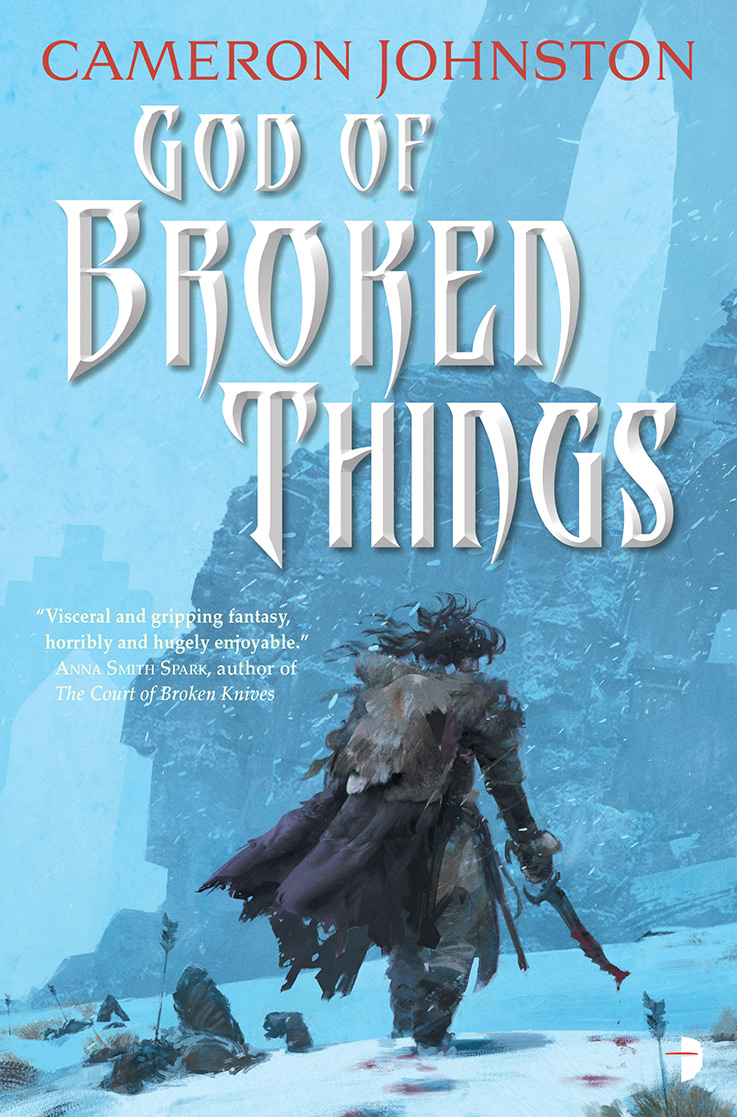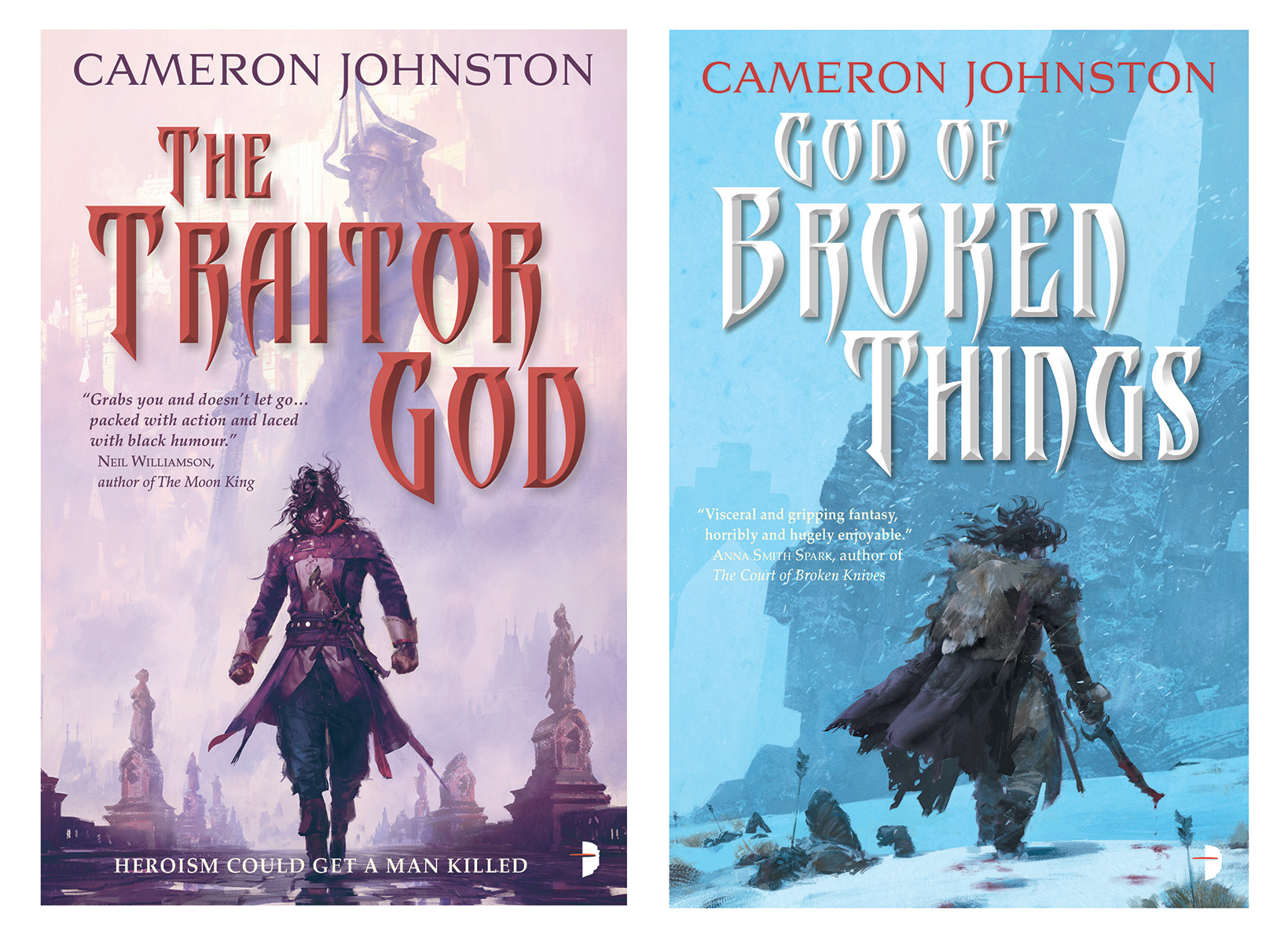We have a two-in-one post for you guys today, as we are proud to reveal the cover for Cameron Johnston’s God of Broken Things, sequel to The Traitor God, which was published in June this year by Angry Robot.
Along with the cover reveal, Cameron has very kindly provided us with a guest post on swords — the king of weapons!
God of Broken Things: Cover Reveal

Cover art by Jan Weßbecher
“From the frantic opening page, The Traitor God grabs you and doesn’t let go. Facing Gods, monsters, and a magic elite that wants him dead, Edrin Walker’s return to Setharis is a noirish romp packed with action and laced with black humour, and marks Cameron Johnston as a real name to watch in the epic fantasy genre.”
– Neil Williamson, author of The Moon King“Cameron Johnston is an exciting new voice in fantasy. His writing has a dark sense of humour and his debut is bursting with imagination and wonders. Fantastic stuff!”
– Stephen Aryan, author of the Age of Darkness trilogy
God of Broken Things is scheduled for release on June 4th, 2019
King of Weapons – The Use of Swords in Fantasy
A guest post by Cameron Johnston
In the realm of fantasy, there is no weapon more iconic than the sword: Excalibur, Stormbringer, Sting, Narsil, Callandor, The Sword of Shannara, The Sword of Truth, The Sword of Omens, Dyrnwyn, The Vorpal Sword, Terminus Est, The Master Sword, and Dragnipur among many, many others. But why, with all of history and human ingenuity to play with, does fantasy focus so much on the sword?
It is every veteran warrior’s first choice when they are heading into battle: the perfect melee weapon, capable of lopping off heads and arms and piercing dragon scale and plate armour with equal ease. It is the Swiss army knife of combat, and the one weapon to rule them all. Some are slender and agile and some are unusually large and probably compensating for something: it’s no mistake this article is titled ‘king of weapons’ and not queen – it’s all very phallic y’see.
Yeeeaaah, and that phallic comment leads me to acknowledge that the preceding paragraph is a load of bollocks, despite how some film and fiction depicts it. Swords are not the finest weapon ever created for every situation. They are mainly cutting weapons, great when fighting unarmoured people, but not so much when facing chain or plate mail. They were mainly a backup weapon to be used when a medieval knight’s main weapon broke or was lost. The simple dagger is more useful when fighting in close proximity or indoors and the spear beats a sword hands down on the battlefield or in an open fight with room to manoeuvre.
The only two things that swords surpass all other melee weapons at are in looking very dashing and swish while wielding a magnificent length of gleaming metal, and (other than the dagger and hatchett) the ease of transport: namely, hanging from your belt, not being too heavy and not getting in the way. Swords look damn cool, we all have to admit it (yes, even you in the back) and there is something inescapably elegant about these weapons, almost noble in form. Back in ye ancient times, when metal was rare and incredibly valuable, only the rich and powerful could afford a sword (I see you, farm boy with an old sword in a trunk that for some inexplicable reason hasn’t rusted away or been sold for seed, food and farming tools). Their purpose was as much status symbol as deadly weapon, and that display of noble wealth has shaped everything that came afterwards – from the romantic ideals of King Arthur and the Knights of the Round Table to Errol Flynn’s swashbuckling escapades and that most gentlemanly duel of all: Dread Pirate Roberts fighting Inigo Montoya in The Princess Bride. Swords are depicted as the weapons of the skilled, while those descended from tools like axes and hammers belong to brutes, and clubs and spears only used by enemy rabble with little training.
Swords are only one more tool in the weapons box, a participant in a deadly game of rock, paper, scissors. Fighting peasants or in a duel? Swords are great. Fighting armoured foes? Might want to consider a long axe, morning star, mace or war hammer, or forgoing that to grapple and stab a dagger into the groin, joint or helmet slit. Spears and pikes ruled most battlefields, offering reach and crowd-control abilities that swords could not match. Even a humble quarterstaff packs a hefty hit when swung, and armour or not, a strike to the side of the knee will drop anybody into the mud. The Roman legionary shield is a perfect weapon (that shield boss could easily mush faces) when combined with a short stabbing gladius for when the enemy are pressed up hard against your wall of shields and their feet poke invitingly beneath the rim. Talking about shields, axes are great for hooking the top of a shield and yanking it down and pulling its wielder off-balance.
With the utility offered by different weapons, other than the cool-factor, why would a character in a fantasy novel use a sword? Mostly, because they are not the rank and file soldiers fighting in lines, they are on the move from place to place carrying their weapon with them. Spears can be handy when outdoors but a character could not effectively fight with one inside a castle, in caves or dense forest, and a sword can be quickly drawn and held with one hand, leaving the other to hold aloft a lantern, open doors etc. Swords, for the most part, are versatile and convenient weapons for everyday use and adventuring but they are outclassed by other weapons in specific circumstances.
So let’s look at how the great variety of swords can tell you an incredible amount about the technology of warfare and the people that made it, reflecting a culture and its opponents. The prime example would be a magic sword thousands of years old found in a dusty and forgotten tomb – 99% of the time it will be depicted as a longsword or katana when that weapon should by all rights look very different to those currently in use by the people and culture who retrieved it. Every weapon is a tool created with a particular purpose in mind beyond simply hacking and slashing and poking holes in people.
- Rapiers, smallswords, and sword-canes are personal defence and duelling weapons designed with quick and agile thrusts in mind that are wholly unsuitable for a battlefield or facing opponents in armour. That long thin blade would be destroyed in no time on a battlefield, but they are light enough to be carried everywhere and tended to be ornate and on display.

- Zweihänder, or two-handed swords, are huge, expensive, and not ideal for swift and deadly personal combat, but perfect for cutting their way through a mass of spears or pikes, or cavalry horses’ legs come that that. These huge weapons would likely need to be carried on a cart when not in use.

- The estoc is a stiff, dull-edged longsword with a flattened diamond-shaped cross-section and a sharp, narrow tip designed with a single purpose in mind: piercing mail links. It could also be used as substitute lance.

- The Egyptian khopesh sickle-word is a combination of bludgeon, cutting edge and hooked tip to catch arms and shield rims that was excellent for getting through or past the wicker shields of the time period it was used it.

- The South Asian urumi sword is a flexible length of steel used more like a flesh-rending whip, and some versions have multiple blades attached giving it a fearsome aspect. It is perhaps the most dangerous sword to the user ever developed, and can be worn as a belt when not in use.

- The long curved blades of sabres are perfect for cutting downwards at head and necks from horseback.

- Cutlasses are short and hefty curved weapons equally suitable for cutting through ropes as in close-quarters boarding actions, and short enough to not get in the way as sailors climbed rigging.

Curved swords are superb at cutting through flesh, but their hard edges chip or quickly deform if used against metal armour, whereas straight swords are superior thrusting weapons if you are looking to pierce the weak points in armoured foes, and as armour technology developed, many war swords got longer and the tips narrower to better pierce mail rings. And as for weapons technology, why is it that most ancient swords are not made of bronze? Bronze weapons are better than iron for short and stiff blades but it’s too brittle a material to fashion into longer weapons with narrow blades unless you want to be left holding a bare hilt when it shatters, and a steel sword can be lighter, stronger, and sharper than both materials.
I for one would like to see a wider variety of weapons wielded by characters in fantasy fiction, but I do love a good sword, so I would happily settle for seeing something other than the ubiquitous longsword or katana.
About The Traitor God:
After ten years on the run, dodging daemons and debt, reviled magician Edrin Walker returns home to avenge the brutal murder of his friend. Lynas had uncovered a terrible secret, something that threatened to devour the entire city. He tried to warn the Arcanum, the sorcerers who rule the city. He failed.
Lynas was skinned alive and Walker felt every cut. Now nothing will stop him from finding the murderer. Magi, mortals, daemons, and even the gods – Walker will burn them all if he has to.
After all, it wouldn’t be the first time he’s killed a god…
Buy the Traitor God on Amazon, or directly from Angry Robot.
About Cameron Johnston:
Cameron Johnston lives in Glasgow, Scotland, with his wife and an extremely fluffy cat. He is a swordsman, a gamer, an enthusiast of archaeology, history and mythology, a builder of LEGO, and owns far too many books to fit on his shelves. He loves exploring ancient sites and camping out under the stars by a roaring fire.


I like the helpful info you provide in your articles. I’ll bookmark your blog
and check again here frequently. I am quite certain I’ll learn lots of new stuff
right here! Good luck for the next!